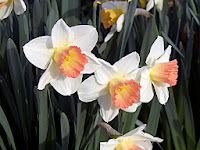Because when you see that fantastic flower or unusual shrub, the season is usually already upon you. Sometimes we luck out and are able to grab one of those beauties and get it into the ground in time to enjoy it. But often, the timing is skewed due to special needs of a particular species (such as the need for spring bulbs to be very cold for at least 6 weeks), or lack ofavailability, or simply our own time limitations. Garden and seed catalogs are a wonderful way to find those special plants and choose the best time to buy them.
What time constraints can affect our ability to have the perfect plant when we want it?
Special needs of the plant
Many bulbs, corms, and tubers require special handling in order to bloom or thrive. Bulbs for daffodils, hyacinth, crocus, narcissus, tulips and other spring bloomers become available to purchase in late fall to early winter. As long as the ground can be worked, these can be planted and will pop up in spring. If not planted until spring, they will only produce leaves – no flowers. These bulbs multiply from season to season, producing lovely large groups of flowers each spring.
Other corms, bulbs, and tubers that are not hardy in the upper zones of the United States must be dug in the fall after the first hard freeze. Examples of such plants are cannas, gladiolas, and dahlias; these plants do well in the warmer USDA zones and can remain in the ground year 'round. Summer blooming bulbs and tubers will be available for purchase in early spring, but should not be planted outdoors until the ground warms to about 50˚F.
Timing of availability in nurseries
 |
| Cannas are worth the work! |
In colder zones, the garden centers and nurseries don't even open until around April, and they will only have stock that is ready to plant at that time. As the season progresses, the selection widens, but sometimes getting what you want will require several visits – not always a bad thing!
Winter or summer shipping constraints
When order plants and bare root perennials from a catalog, be sure to check the shipping schedule. These companies will ship your plants to you based on your planting zone requirements (USDA). However, weather conditions can change from season to season, and what would have been plantable in mid-April one year might have to wait until mid-May the next. But the plants will arrive on your doorstep regardless of whether you can plant them immediately. You'll need to plan how to handle the products until you can put them in the ground.
 |
| Dwarf dahlias brighten any garden |
 |
| Gladiolus 'Wine & Roses' |
Shipping schedules will also take severe weather months into account. Live plants cannot be shipped during freezing weather or during the hottest summer months. Planning your purchase and getting your order in early will help prevent disappointment from either out-of-stock plants, or missed shipping deadlines.
Finding the time to actually seek out the plant, buy it, and plant it
In our busy lives, often the opportunity to go shopping for plants just never happens, or comes late enough in the season that we don't get to enjoy the fruits of our labor. Plant catalogs are an excellent way to get around this time trap. I happen to love leafing through a physical catalog, oohing and ahhing over the photographs and dog-earring page after page of "must-haves", but most of the bigger mail-order nurseries have wonderful online shopping sites. What could be better on a cold winter evening than browsing through the flowers and shrubs that will grace your garden, come spring?






No comments:
Post a Comment